How to pass 70-410 exam easily? Are you struggling for the 70-410 exam? Good news, GreatExam Microsoft technical experts have collected all the questions and answers which are updated to cover the knowledge points and enhance candidates’ abilities. We offer the latest 70-410 PDF and VCE dumps with new version VCE player for free download, and the new 70-410 practice test ensures your 70-410 exam 100% pass.
QUESTION 71
Your company has a main office and two branch offices. The offices connect to each other by using a WAN link. In the main office, you have a server named Server1 that runs Windows Server 2012 R2. Server1 is configured to use an IPv4 address only.
You need to assign an IPv6 address to Server1. The IP address must be private and routable. Which IPv6 address should you assign to Server1?
A. fe80:ab32:145c::32cc:401b
B. ff00:3fff:65df:145c:dca8::82a4
C. 2001:ab32:145c::32cc:401b
D. fd00:ab32:14:ad88:ac:58:abc2:4
Answer: D
Explanation:
pg 266 Chapter 6 : Installing and Configuring Windows Server 2012 R2 Unique local addresses
Unique local addresses are IPv6 addresses that are private to an organization in the same way that private addresses–such as 10.x.x.x, 192.168.x.x, or 172.16.0.0 172.31.255.255–can be used on an IPv4 network.
Unique local addresses, therefore, are not routable on the IPv6 Internet in the same way that an address like 10.20.100.55 is not routable on the IPv4 Internet. A unique local address is always structured as follows:
The first 8 bits are always 11111101 in binary format. This means that a unique local address always begins with FD and has a prefix identifier of FD00::/8.
QUESTION 72
Your network contains an Active Directory domain named contoso.com. All client computers run Windows 8.
You deploy a server named Server1 that runs Windows Server 2012 R2.
You install a new client-server application named App1 on Server1 and on the client computers. The client computers must use TCP port 6444 to connect to App1 on Server1. Server1 publishes the information of App1 to an intranet server named Server2 by using TCP port 3080.
You need to ensure that all of the client computers can connect to App1.
The solution must ensure that the application can connect to Server2.
Which Windows Firewall rule should you create on Server1?
A. an inbound rule to allow a connection to TCP port 3080
B. an outbound rule to allow a connection to TCP port 3080
C. an outbound rule to allow a connection to TCP port 6444
D. an inbound rule to allow a connection to TCP port 6444
Answer: D
Explanation:
A. Server2 needs inbound on 3080
B. All ports outbound allowed by default
D. Server1 gets request from Client PC’s it needs a inbound rule for 6444
By default, Windows Firewall with Advanced Security blocks all unsolicited inbound networktraffic, and allows all outbound network traffic. For unsolicited inbound network traffic to reach your computer, you must create an allow rule to permit that type of network traffic. If a network program cannot get access, verify that in the Windows Firewall with Advanced Security snap-in there is an active allow rule for the current profile. To verify that there is an active allow rule, double-click Monitoring and then click Firewall.
If there is no active allow rule for the program, go to the Inbound Rules node and create a new rule for that program. Create either a program rule, or a service rule, or search for a group that applies to the feature and make sure all the rules in the group are enabled. To permit the traffic, you must create a rule for the program that needs to listen for that traffic. If you know the TCP or UDP port numbers required by the program, you can additionally restrict the rule to only those ports, reducing the vulnerability of opening up all ports for the program.
http://social.technet.microsoft.com/wiki/contents/articles/13894.troubleshooting-windows-firewall-with-advanced-security-in-windows-server-2012.aspx
QUESTION 73
Your network contains an Active Directory domain named contoso.com.
All user accounts in the sales department reside in an organizational unit (OU) named OU1.
You have a Group Policy object (GPO) named GPO1. GPO1 is used to deploy a logon script to all of the users in the sales department.
You discover that the logon script does not run when the sales users log on to their computers. You open Group Policy Management as shown in the exhibit.
You need to ensure that the logon script in GPO1 is applied to the sales users.
What should you do?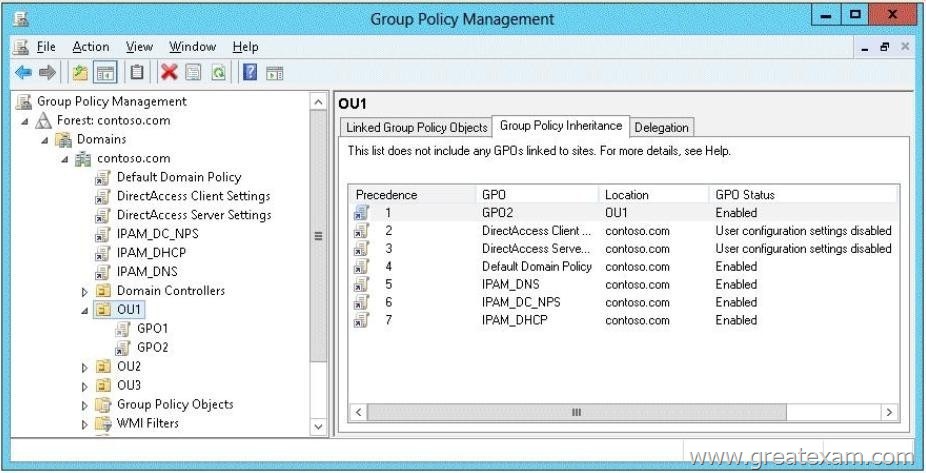
A. Enforce GPO1.
B. Modify the link order of GPO1.
C. Modify the Delegation settings of GPO1.
D. Enable the link of GPO1.
Answer: D
Explanation:
D. GPO1 needs to be linked to OU1
http://technet.microsoft.com/en-us/library/cc732979.aspx
http://technet.microsoft.com/en-us/library/cc776004%28v=ws.10%29.aspx#BKMK_icons_link
QUESTION 74
Your network contains an Active Directory domain named contoso.com.
All servers run Windows Server 2012 R2.
The domain contains a server named Server1.
You install the Windows PowerShell Web Access gateway on Server1.
You need to provide administrators with the ability to manage the servers in the domain by using the Windows PowerShell Web Access gateway.
Which two cmdlets should you run on Server1? (Each correct answer presents part of the solution. Choose two.)
A. Set-WSManQuickConfig
B. Set-WSManInstance
C. Add-PswaAuthorizationRule
D. Set-BCAuthentication
E. Install-PswaWebApplication
Answer: CE
Explanation:
A. Configures the local computer for remote management.
B. Modifies the management information that is related to a resource.
C. Adds a new authorization rule to the Windows PowerShell Web Access authorization rule set. D. Specifies the BranchCache computer authentication mode.
E. Configures the Windows PowerShell ® Web Access web Application in IIS.
http://technet.microsoft.com/en-us/library/hh849867.aspx
http://technet.microsoft.com/en-us/library/hh849875.aspx
http://technet.microsoft.com/en-us/library/jj592890(v=wps.620).aspx http://technet.microsoft.com/en-us/library/hh848404(v=wps.620).aspx http://technet.microsoft.com/en-us/library/jj592894(v=wps.620).aspx
QUESTION 75
You have a server named Server 1 that runs Windows Server 2012 R2. Server 1 has the Hyper-V server role installed.
You have fixed-size VHD named Files.vhd.
You need to make the contents in Files.vhd available to several virtual machines. The solution must meet the following requirements:
– Ensure that if the contents are changed on any virtual machine, the changes are not reflected on the other virtual machines.
– Minimize the amount of disk space used.
What should you do?
A. Create a fixed-size VHDX. Transfer the information from Files.vhd to the new VHDX file.
B. Convert Files.vhd to a dynamically expanding VHD?
C. Create a dynamically expanding VHDX. Transfer the information from Files.vhd to the new VHDX file.
D. Create differencing VHDs that use Files.vhd as the parent disk.
Answer: D
Explanation:
A. A conversion would be needed from VHD to VHDX. Not available to multiple VM’s
B. Single VHD not available to multiple VM’s. Changes wouldn’t be reflected
C. A conversion would be needed from VHD to VHDX. Not available to multiple VM’s
D. Child disk for multiple VM’s with Files.vhd as parent A differencing disk is associated with another virtual hard disk that you select when you create the differencing disk. This means that the disk to which you want to associate the differencing disk must exist first. This virtual hard disk is called the “parent” disk and the differencing disk is the “child” disk.
The parent disk can be any type of virtual hard disk.
The differencing disk stores all changes that would otherwise be made to the parent disk if the differencing disk was not being used. The differencing disk provides an ongoing way to save changes without altering the parent disk.
You can use the differencing disk to store changes indefinitely, as long as there is enough space on the physical disk where the differencing disk is stored. The differencing disk expands dynamically as data is written to it and can grow as large as the maximum size allocated for the parent disk when the parent disk was created.
http://technet.microsoft.com/en-us/library/cc720381(v=ws.10).aspx
QUESTION 76
Your network contains an Active Directory domain named adatum.com. The domain contains several thousand member servers that run Windows Server 2012 R2. All of the computer accounts for the member servers are in an organizational unit (OU) named ServersAccounts. Servers are restarted only occasionally.
You need to identify which servers were restarted during the last two days.
What should you do?
A. Run dsquery computer and specify the -stalepwd parameter
B. Run dsquery server and specify the -o parameter.
C. Run Get-ADComputer and specify the lastlogon property.
D. Run Get-ADComputer and specify the SearchScope parameter
Answer: C
Explanation:
A. dsquery computer -stalepwdnumber_of_days – Searches for all computers that have not changed theirpassword for the specified number_of_days.
B. dsquery server -o {dn | rdn | samid} – Specifies the format in which the list of entries found by the search willbe displayed: dn distinguished name of each entry, default; rdn relative distinguished name of each entry;
samid SAM account name of each entry computer group server user; upn user principal name of each entryuser
C. Gets one or more Active Directory computers lastLogondate should be used
D. SearchScope specifies the scope of an Active Directory search. Possible values for this parameter are:
Base or 0; OneLevel or 1; Subtree or 2 – A Base query searches only the current path or object.
A One Level query searches the immediate children of that path or object.
A Subtree query searches the current path orobject and all children of that path or object.
http://technet.microsoft.com/en-us/library/ee617192.aspx
http://technet.microsoft.com/en-us/library/cc732952(v=ws.10).aspx
QUESTION 77
Your network contains three servers that run Windows Server 2012 R2. The servers are configured as shown in the following table (click Exhibit). Server3 is configured to obtain an IP address automatically.
You need to ensure that Server3 only receives an IP address from Server1.
The IP address must always be the same.
Which two tasks should you perform? (Each correct answer presents part of the solution. Choose two.)
A. Create an exclusion on Server1.
B. Create a filter on Server1.
C. Create a reservation on Server2
D. Create a reservation on Server1
E. Create a filter on Server2.
Answer: DE
Explanation:
A. Exclude range of IP’s for lease
B. Wrong Server
C. Wrong Sever
D. For clients that require a constant IP address, you can either manually configure a static IP address,or assign a reservation on the DHCP server
E. DHCP Deny Filter at Server2 to exclude MAC address of Server3 MAC address filterEnable and define an explicit allow list. The DHCP server provides DHCP services only to clients whose MACaddresses are in the allow list. Any client that previously received IP addresses is denied address renewal if its MAC address isn’t onthe allow list.
Enable and define an explicit deny list. The DHCP server denies DHCP services only to clients whose MACaddresses are in the deny list.
Any client that previously received IP addresses is denied address renewal if its MAC address is on thedeny list.
Enable and define an allow list and a block list.
The block list has precedence over the allow list. This means that the DHCP server provides DHCPservices only to clients whose MAC addresses are in the allow list, provided that no corresponding matchesare in the deny list.
If a MAC address has been denied, the address is always blocked even if the address is on the allowlist.
http://technet.microsoft.com/en-us/library/cc754537(v=ws.10).aspx http://technet.microsoft.com/en-us/magazine/ff521761.aspx
http://technet.microsoft.com/en-us/library/cc779507(v=ws.10).aspx
QUESTION 78
Your network contains an Active Directory domain named contoso.com. The domain contains a domain controller named DC1 that runs Windows Server 2012 R2 and a client computer named Computer1 that runs Windows 8. DC1 is configured as a DHCP server as shown in the exhibit. (Click the Exhibit button.) Computer1 is configured to obtain an IP address automatically.
You need to ensure that Computer1 can receive an IP address from DC1.
What should you do?
A. Disable the Allow filters.
B. Disable the Deny filters
C. Activate Scope [10.1.1.0] Contoso.com.
D. Authorize dc1.contoso.com.
Answer: D
Explanation:
Red down arrow indicates a unauthorized DHCP server A DHCP server that is a domain controller or a member of an Active Directory domain queries Active Directoryfor the list of authorized servers (identified by IP address). If its own IP address is not in the list of authorized DHCP servers, the DHCP Server service does not completeits startup sequence and automatically shuts down. http://technet.microsoft.com/en-us/library/cc754792.aspx
http://technet.microsoft.com/en-us/library/ee941131(v=ws.10).aspx http://technet.microsoft.com/en-us/library/gg722802(v=ws.10).aspx
http://pc-addicts.com/server-2012-dhcp-server-role/
QUESTION 79
Your network contains an Active Directory domain named contoso.com. The domain contains a domain controller named Server1 that has the DNS Server server role installed. Server1 hosts a primary zone for contoso.com. The domain contains a member server named Server2 that is configured to use Server1 as its primary DNS server. From Server2, you run nslookup.exe as shown in the exhibit. (Click the Exhibit button.)
You need to ensure that when you run Nslookup, the correct name of the default server is displayed.
What should you do?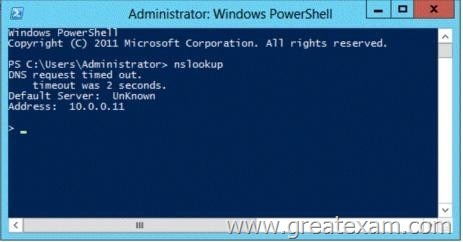
A. From Advanced TCP/IP Settings on Server1, add contoso.com to the DNS suffix list
B. On Server1, modify the Security settings of the contoso.com zone
C. On Server1, create a reverse lookup zone.
D. From Advanced TCP/IP Settings on Server2, add contoso.com to the DNS suffix list
Answer: C
Explanation:
C. Make sure that a reverse lookup zone that is authoritative for the PTR resource record exists. For more information about adding a reverse lookup zone, see “Adding a Reverse Lookup Zone” http://technet.microsoft.com/en-us/library/cc961417.aspx
QUESTION 80
Your network contains an Active Directory domain named contoso.com. The domain contains a domain controller named DC1 that hosts the primary DNS zone for contoso.com. All client computers are configured to use DC1 as the primary DNS server.
You need to configure DC1 to resolve any DNS requests that are not for the contoso.com zone by querying the DNS server of your Internet Service Provider (ISP).
What should you configure?
A. Name server (NS) records
B. Condition& forwarders
C. Forwarders
D. Naming Authority Pointer (NAPTR) DNS resource records (RR)
Answer: C
Explanation:
A. Specifies a name server for the domain, which allows DNS lookups within various zones. Each primary andsecondary name server should be declared through this record.
B. http://windowsitpro.com/networking/q-whats-conditional-dns-forwarding
C. manage the Domain Name System (DNS) traffic between your network and the Internet
D.Configure forwarders to send DNS queries directly to your ISP’s DNS server or other DNS servers. Most of the time, when you configure forwarders, DNS performance and efficiency increases, but thisconfiguration can also introduce a point of failure if the forwarding DNS server is experiencing problems.
A forwarder is a Domain Name System (DNS) server on a network used to forward DNS queries for externalDNS names to DNS servers outside of that network. A DNS server on a network is designated as a forwarder by having the other DNS servers in the networkforward the queries they cannot resolve locally to that DNS server. By using a forwarder, you can manage name resolution for names outside of your network, such as names onthe Internet, and improve the efficiency of name resolution for the computers in your network.
http://social.technet.microsoft.com/Forums/en-US/winserverNIS/thread/2f35cae2-341c4bfe-9dac- 724ddace6d51/
http://technet.microsoft.com/en-us/library/cc722542.aspx
http://technet.microsoft.com/en-us/library/cc754931.aspx
QUESTION 81
Your network contains an Active Directory domain named contoso.com. All domain controllers run Windows Server 2012 R2. The domain contains a server named Server1 that runs Windows Server 2012 R2.
You need to ensure that when users log on to Server1, their user account is added automatically to a local group named Group1 during the log on process.
Which Group Policy settings should you modify?
A. Restricted Groups
B. Security Options
C. User Rights Assignment
D. Preferences
Answer: D
Explanation:
A. If a Restricted Groups policy is defined and Group Policy is refreshed, any current member not on the Restricted Groups policy members list is removed
B. Security settings incorporated into policies are rules that administrators configure on a computer or multiple computers for the purpose of protecting resources on a computer
C. User Rights Assignment policies determines which users or groups have logon rights or privileges on the computer
D. With Preferences, local and domain accounts can be added to a local group without affecting the existing members of the group
http://technet.microsoft.com/en-us/library/cc785631(v=ws.10).aspx http://www.grouppolicy.biz/2010/01/how-to-use-group-policy-preferences-to-secure- localadministrator-groups/
http://technet.microsoft.com/en-us/library/cc780182(v=ws.10).aspx http://technet.microsoft.com/en-us/library/hh831424.aspx
QUESTION 82
Your network contains an Active Directory domain named contoso.com.
You need to prevent users from installing a Windows Store app named App1.
What should you create?
A. An application control policy executable rule
B. An application control policy packaged app rule
C. A software restriction policy certificate rule
D. An application control policy Windows Installer rule
Answer: B
Explanation:
Windows 8 is coming REALLY SOON and of course one of the big new things to computer with that is the newPackaged Apps that run in the start screen. However these apps are very different and do not install liketraditional apps to a path or have a true “executable” file to launch the program. Ofcourse enterprises need a way to control these packaged apps and therefore Microsoft has added a newfeature Packaged Apps option to the App1ocker feature.
A. For .exe or .com
B. A publisher rule for a Packaged app is based on publisher, name and version
C. You can create a certificate rule that identifies software and then allows or does not allow the software torun, depending on the security level.
D. For .msi or .msp
Packaged apps (also known as Windows 8 apps) are new to Windows Server 2012 R2 and Windows 8. They are based on the new app model that ensures that all the files within an app package share the sameidentity.
Therefore, it is possible to control the entire Application using a single App1ocker rule as opposed to the nonpackagedapps where each file within the app could have a unique identity. Windows does not support unsigned packaged apps which implies all packaged apps must be signed. App1ocker supports only publisher rules for Packaged apps. A publisher rule for a Packaged app is based on the following information:
Publisher of the package
Package name
Package version
Therefore, an App1ocker rule for a Packaged app controls both the installation as well as the running of theapp. Otherwise, the publisher rules for Packaged apps are no different than the rest of the rule collections; theysupport exceptions, can be increased or decreased in scope, and can be assigned to users and groups.
http://technet.microsoft.com/en-us/library/dd759068.aspx
http://technet.microsoft.com/en-us/library/hh994588.aspx
http://www.grouppolicy.biz/2012/08/how-manage-published-a-k-a-metro-apps-in-windows8-using- grouppolicy/
http://technet.microsoft.com/en-us/library/hh994597.aspx#BKMK_Cert_Rules Packaged
Apps run in the start screen.
However these apps are very different and do not install like traditional apps to a path or have a true”executable” file to launch the program.
Enterprises need a way to control these packaged apps and therefore Microsoft has added a new featurePackaged Apps option to the App1ocker feature.
QUESTION 83
Your company’s security policy states that all of the servers deployed to a branch office must not have the graphical user interface (GUI) installed. In a branch office, a support technician installs a server with a GUI installation of Windows Server 2012 on a new server, and then configures the server as a DHCP server.
You need to ensure that the new server meets the security policy.
You want to achieve this goal by using the minimum amount of Administrative effort.
What should you do?
A. Reinstall Windows Server 2012 on the server.
B. From Windows PowerShell, run Uninstall-WindowsFeature Desktop-Experience.
C. From Windows PowerShell, run Uninstall-WindowsFeature PowerShell-ISE.
D. From Server Manager, uninstall the User Interfaces and Infrastructure feature.
Answer: D
Explanation:
A. Not least effort
B. Uninstalls desktop experience not the full GUI
C. Uninstalls the powershell ISE
D. Least effort and removes full GUI
http://www.howtogeek.com/111967/how-to-turn-the-gui-off-and-on-in-windows-server-2012/ http://technet.microsoft.com/en-us/library/cc772567.aspx http://blogs.technet.com/b/server_core/archive/2012/05/09/configuring-the-minimal- serverinterface.aspx
QUESTION 84
Your network contains an Active Directory domain named contoso.com. The domain contains 500 servers that run Windows Server 2012 R2.
You have a written security policy that states the following:
– Only required ports must be open on the servers.
– All of the servers must have Windows Firewall enabled.
– Client computers used by Administrators must be allowed to access all of the ports on all of the servers.
– Client computers used by the Administrators must be authenticated before the client computers can access the servers.
You have a client computer named Computer1 that runs Windows 8.
You need to ensure that you can use Computer1 to access all of the ports on all of the servers successfully. The solution must adhere to the security policy.
Which three actions should you perform? (Each correct answer presents part of the solution. Choose three.)
A. On Computer1, create a connection security rule
B. On all of the servers, create an outbound rule and select the Allow the connection if it is secureoption.
C. On all of the servers, create an inbound rule and select the Allow the connection if it is secureoption.
D. On Computer1, create an inbound rule and select the Allow the connection if it is secureoption.
E. On Computer1, create an outbound rule and select the Allow the connection if it is secureoption
F. On all of the servers, create a connection security rule
Answer: ACF
Explanation:
http://technet.microsoft.com/en-us/library/cc772017.aspx
Unlike firewall rules, which operate unilaterally, connection security rules require that both communicating computers have a policy with connection security rules or another compatible IPsec policy.
http://technet.microsoft.com/en-us/library/cc753463.aspx
Traffic that matches a firewall rule that uses the Allow connection if it is secure setting bypasses Windows Firewall. The rule can filter the traffic by IP address, port, or protocol. This method is supported on Windows Vista or Windows Server 2008.
QUESTION 85
Drag and Drop Question
Your network contains three servers. The servers are configured as shown in the following table.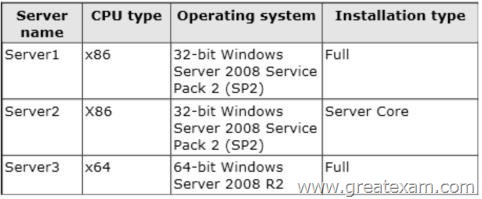
Your company plans to standardize all of the servers on Windows Server 2012 R2.
You need to recommend an upgrade path for each server.
The solution must meet the following requirements:
– Upgrade the existing operating system whenever possible.
– Minimize hardware purchases.
Which upgrade path should you recommend for each server? To answer, drag the appropriate upgrade path to each server in the answer area. Each upgrade path may be used once, more than once, or not at all.
Answer:
Explanation:
Server1 not 64-bit processor
Server2 not 64-bit processor
Server3 64-bit processor, needs 2008 SP1
http://blogs.technet.com/b/askcore/archive/2012/10/23/upgrading-to-windows-server-2012-part-1.aspx
http://technet.microsoft.com/en-us/library/jj134246.aspx
QUESTION 86
Your network contains a file server named Server1 that runs Windows Server 2012 R2. All client computers run Windows 8. Server1 contains a folder named Folder1. Folder1 contains the installation files for the company’s desktop applications.
A network technician shares Folder1 as Share 1.
You need to ensure that the share for Folder1 is not visible when users browse the network.
What should you do?
A. From the properties of Folder1, deny the List Folder Contents permission for the Everyone group.
B. From the properties of Folder1, remove Share1, and then share Folder1 as Share1$.
C. From the properties of Folder1, configure the hidden attribute.
D. From the properties of Share1, configure access-based enumeration
Answer: B
Explanation:
A. Will deny everyone list of folder content
B. Remove share and re-add using $ for Hidden/Administrative share
C. This will hide the physical folder
D. lists only the files and folders to which they have access when browsing content on the file server A hidden share is identified by a dollar sign ($) at the end of the share name
Hidden shares are not listed when you look through the shares on a computer or use the “net view” command
Why Use Hidden Shares?
Using hidden shares on your network is useful if you do not want a shared folder or drive on the network to beeasily accessible. Hidden shares can add another layer of protection for shared files against unauthorizedpeople connecting to your network. Using hidden shares helps eliminate the chance for people to guess yourpassword (or be logged into an authorized Windows account) and then receive access to the shared resource.
http://support.microsoft.com/kb/314984
http://technet.microsoft.com/en-us/library/cc784710(v=ws.10).aspx
QUESTION 87
Your network contains an Active Directory domain named contoso.com. The domain contains a server named Server1 that runs Windows Server 2012 R2 and a server named Server2 that runs Windows Server 2008 R2 Service Pack 1 (SP1). Both servers are member servers. On Server2, you install all of the software required to ensure that Server2 can be managed remotely from Server Manager.
You need to ensure that you can manage Server2 from Server1 by using Server Manager.
Which two tasks should you perform on Server2? (Each correct answer presents part of the solution. Choose two.)
A. Run the systempropertiesremote.execommand
B. Run the Enable-PsRemotingcmdlet.
C. Run the Enable-PsSessionConfigurationcmdlet
D. Run the Confiqure-SMRemoting.ps1script
E. Run the Set-ExecutionPolicycmdlet.
Answer: DE
Explanation:
To configure Server Manager remote management by using Windows PowerShell On the computer that you want to manage remotely, open a Windows PowerShell session with elevated user rights. To do this, click Start, click All Programs, click Accessories, click Windows PowerShell, right-click the Windows PowerShell shortcut, and then click Run as administrator. In the Windows PowerShell session, type the following, and then press Enter.
Set-ExecutionPolicy -ExecutionPolicyRemoteSigned
Type the following, and then press Enter to enable all required firewall rule exceptions.
Configure-SMRemoting.ps1 -force -enable
http://technet.microsoft.com/en-us/library/dd759202.aspx A)
Run the systempropertiesremote.exe command
B) Enable-PSRemotingcmdlet configures the computer to receive Windows PowerShell remote commandsthat are sent by using the WS-Management technology.
C) Enable-PSSessionConfigurationcmdlet enables registered session configurations that have been disabled.
D) Configure-SMRemoting.ps1 -force -enable
E) Set-ExecutionPolicy -ExecutionPolicyRemoteSigned
To configure Server Manager remote management by using Windows PowerShell On the computer that you want to manage remotely, open a Windows PowerShell session with elevated userrights, type the following:
To configure Server Manager remote management by using Windows PowerShell. On the computer that youwant to manage remotely, open a Windows PowerShell session with elevated user rights. To do this, click Start, click All Programs, click Accessories, click Windows PowerShell, right-click the WindowsPowerShell shortcut, and then click Run as administrator. In the Windows PowerShell session, type thefollowing, and then press Enter. Set-ExecutionPolicy –
ExecutionPolicyRemoteSigned Type the following, and then press Enter to enable allrequired firewall rule exceptions.
Configure-SMRemoting.ps1 -force -enable
http://technet.microsoft.com/en-us/library/dd759202.aspx
QUESTION 88
Hotspot Question
Your network contains an Active Directory domain named contoso.com. The domain contains a print server named Server1 that runs Windows Server 2012 R2.
You share several printers on Server1.
You need to ensure that you can view the printer objects associated to Server1 in Active Directory Users and Computers.
Which option should you select? To answer, select the appropriate option in the answer area.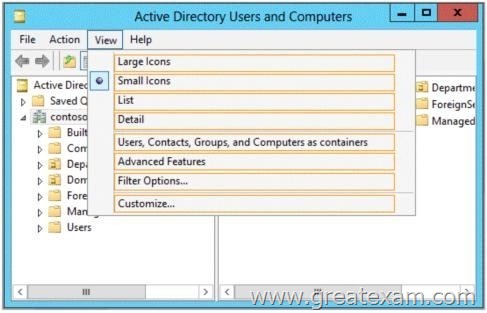
Answer: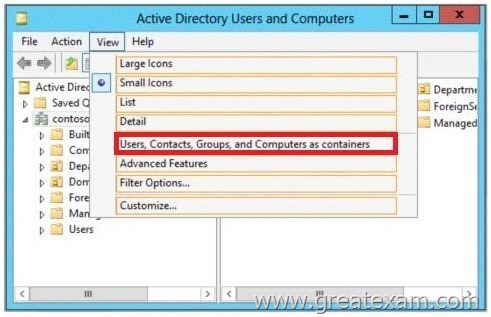
Explanation:
You can view printer objects in Active Directory by clicking Users, Groups, and Computers as containers from the View menu in the Active Directory Users and Computers snap-in.
By default, printer objects are created under the machine object in which they are shared. After you turn on the Users, Groups, and Computers as containers option, you can see printers by expanding the printer’s host computer.
http://support.microsoft.com/kb/235925
QUESTION 89
Your network contains an Active Directory domain named contoso.com. The domain contains two member servers named Server1 and Server2 that run Windows Server 2012 R2.
You log on to Server1.
You need to retrieve the IP configurations of Server2.
Which command should you run from Server1?
A. winrs -r:server2 ipconfig
B. winrm get server2
C. dsquery *-scope base-attr ip, server2
D. ipconfig > server2.ip
Answer: A
Explanation:
A. Windows Remote Management allows you to manage and execute programs remotely
B. winrm is the server side services for remote mgmt
C. dsquery * finds any objects in the directory according to criteria using a LDAP query.
D. Would output server1 ipconfig info to server2.ip file
http://technet.microsoft.com/en-us/library/dd349801(v=ws.10).aspx
QUESTION 90
You work as an administrator at L2P.com. The L2P.com network consists of a single domain named L2P.com. All servers on the L2P.com network have Windows Server 2008 R2 installed. Some of L2P.com’s workstations have Windows 7 installed, while the rest have Windows 8 installed.
After installing a new Windows Server 2012 computer in the L2P.com domain, you configure it to run the File and Storage Services server role. You are instructed to create a shared folder on the new server, and configure the use of Previous Versions for restoring files located in the shared folder.
Which of the following actions should you take?
A. You should consider configuring the Shadow Copies settings on the new server.
B. You should consider configuring the Snapshot settings on the new server.
C. You should consider configuring the Background Copy settings on the new server.
D. You should consider configuring the Permission settings on the new server.
Answer: A
Explanation:
What are previous versions?
Previous versions are either backup copies (copies of files and folders that you back up by using the Back Up Files wizard, or shadow copies) copies of files and folders that Windows automatically saves as part of a restore point. (Shadow copies can be copies of files on your computer or shared files on acomputer on a network.) You can use previous versions of files to restore files that you accidentally modified or deleted, or that were damaged. Depending on the type of file or folder, you can open, save to a different location, or restore a previous version.
ATT: ( nothing to do with question but cool to know ) File Server Volume Copy Shadow Service (VSS) Agent Service Enables consistency of application snaphots (shadow copies). With previous versions of Windows Server, VSS only supported shadow copies of data on the local server. With WS2012, Microsoft has added VSS for SMB File Shares which extends shadow copy support for network volumes.Administrators install the FS VSS Agent on the file server where the application data is located. They then install the VSS provider in the server where the application is located. The provider talks to the agent using the new File Server Remote VSS protocol in order to manage the shadow copies of the data.
http://windows.microsoft.com/en-gb/windows-vista/previous-versions-of-files-frequently-asked-questions
GreatExam Microsoft 70-410 exam dumps are audited by our certified subject matter experts and published authors for development. GreatExam Microsoft 70-410 exam dumps are one of the highest quality Microsoft 70-410 Q&As in the world. It covers nearly 96% real questions and answers, including the entire testing scope. GreatExam guarantees you pass Microsoft 70-410 exam at first attempt.